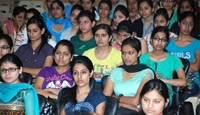Supernumerary seats for women in technical education
Sakshi Education
The share of women participation in the fields of Science, Technology, Engineering and Math is very low in the country.


According to the Department of Science and Technology 2017–18 data, only 14 percent of women are working in the areas of research and development. Hence, the Ministry of Human Resources Development (MHRD) has taken steps to encourage women from the basic level of technical education. As part of this, it has decided to provide supernumerary seats for women in undergraduate courses in Indian Institutes of Technology (IITs) and the National Institutes of Technology (NITs).
Let us know about the policy and benefits of the supernumerary seats in IITs and NITS…
The seats that are added to current seats, to increasethe percentage of female students in the undergraduate level of engineering and technical courses at IITs, NITs and other government-funded technical institutes are called supernumerary seats.
With the aim of increasing the participation of female students in technical education, the Ministry of Human Resources Development (MHRD) has introduced 14 per cent women supernumerary seats in 2018–19. It has been increased to 17 percent in 2019–20 and further to 20percent for 2020-21, so as to increase the number of students’ enrollment in technical education.
This supernumerary seat system is designed in such a way that there won’t be any reduction in un-reserved category seats, but the concerned institutes have to increase the total number of seats.
More seats this time…
Joint admission process in to IITs, NITs, IIST, IIITs and other Central Government funded technical institutes is through JoSSA. MHRD has implemented the JoSSA (Joint Seat Allocation Authority)policy. Accordingly, 1120additional,supernumerary seats were added to the IITs in the academic year (2019-20). Also, 705 supernumerary seats in the NITs and 96 supernumerary seats in the triplets were created.
Other government-funded technical institutes for women have increased their number of supernumerary seatsto 37. Enrollment of female students in B. Tech courses in IITs was just 8% in 2016 and it has reached to 18% by 2019. With the decision to increase the supernumerary quota by 20% in the academic year2020–21, more female enrollment is expected in the technical institutes.
Seat allocation
While allocating the supernumerary seats some guidelines have to be followed. Supernumerary seats have to be added to the existing previous year’s seats.Admission to IITs is through the scores in JEE (Advanced) -2020 and counseling. As per the Government of India regulations, reservation policy is applicable to supernumerary seats also.
Encouraging the female students
There is a little representation of women in the fields of science and technology, both abroad and in the country. If the number of women in the respective fields is to be increased, they should be specifically encouraged. Girls should also be given coaching for entrance exams on par with boys. Then only, the girls will be able to compete equally with the boys. It is a good decision to provide supernumerary seatsin technical institutes including IITs and NITs,which increases the percentage of women representation the respective institutions and other fields. It will increase the self confidence in female students. Governments must continue to provide women with the opportunity to pursue higher education, research and career. We are lagging far behind most countries in female employment. With more supernumerary seats in technical institutes we can increase the female employability.
- Dr. Lakshmi Lingam, Professor, Tata Institute of Social Sciences, Mumbai.
It is useful to them
Supernumerary seats in undergraduate courses in technical institutes are availableby the direction of the Ministry of Human Resources. Supernumerary seats are expected to increase by 20 percent this year. This will certainly benefit the female students. The number of female enrollment in engineering and technical undergraduate courses is expected to increase for sure.
- Professor K. N. S. Kasi Viswanatham, Chairman (Admissions), NIT Warangal.
Let us know about the policy and benefits of the supernumerary seats in IITs and NITS…
The seats that are added to current seats, to increasethe percentage of female students in the undergraduate level of engineering and technical courses at IITs, NITs and other government-funded technical institutes are called supernumerary seats.
With the aim of increasing the participation of female students in technical education, the Ministry of Human Resources Development (MHRD) has introduced 14 per cent women supernumerary seats in 2018–19. It has been increased to 17 percent in 2019–20 and further to 20percent for 2020-21, so as to increase the number of students’ enrollment in technical education.
This supernumerary seat system is designed in such a way that there won’t be any reduction in un-reserved category seats, but the concerned institutes have to increase the total number of seats.
More seats this time…
Joint admission process in to IITs, NITs, IIST, IIITs and other Central Government funded technical institutes is through JoSSA. MHRD has implemented the JoSSA (Joint Seat Allocation Authority)policy. Accordingly, 1120additional,supernumerary seats were added to the IITs in the academic year (2019-20). Also, 705 supernumerary seats in the NITs and 96 supernumerary seats in the triplets were created.
Other government-funded technical institutes for women have increased their number of supernumerary seatsto 37. Enrollment of female students in B. Tech courses in IITs was just 8% in 2016 and it has reached to 18% by 2019. With the decision to increase the supernumerary quota by 20% in the academic year2020–21, more female enrollment is expected in the technical institutes.
Seat allocation
While allocating the supernumerary seats some guidelines have to be followed. Supernumerary seats have to be added to the existing previous year’s seats.Admission to IITs is through the scores in JEE (Advanced) -2020 and counseling. As per the Government of India regulations, reservation policy is applicable to supernumerary seats also.
Encouraging the female students
There is a little representation of women in the fields of science and technology, both abroad and in the country. If the number of women in the respective fields is to be increased, they should be specifically encouraged. Girls should also be given coaching for entrance exams on par with boys. Then only, the girls will be able to compete equally with the boys. It is a good decision to provide supernumerary seatsin technical institutes including IITs and NITs,which increases the percentage of women representation the respective institutions and other fields. It will increase the self confidence in female students. Governments must continue to provide women with the opportunity to pursue higher education, research and career. We are lagging far behind most countries in female employment. With more supernumerary seats in technical institutes we can increase the female employability.
- Dr. Lakshmi Lingam, Professor, Tata Institute of Social Sciences, Mumbai.
It is useful to them
Supernumerary seats in undergraduate courses in technical institutes are availableby the direction of the Ministry of Human Resources. Supernumerary seats are expected to increase by 20 percent this year. This will certainly benefit the female students. The number of female enrollment in engineering and technical undergraduate courses is expected to increase for sure.
- Professor K. N. S. Kasi Viswanatham, Chairman (Admissions), NIT Warangal.
Published date : 29 Apr 2020 02:33PM


















